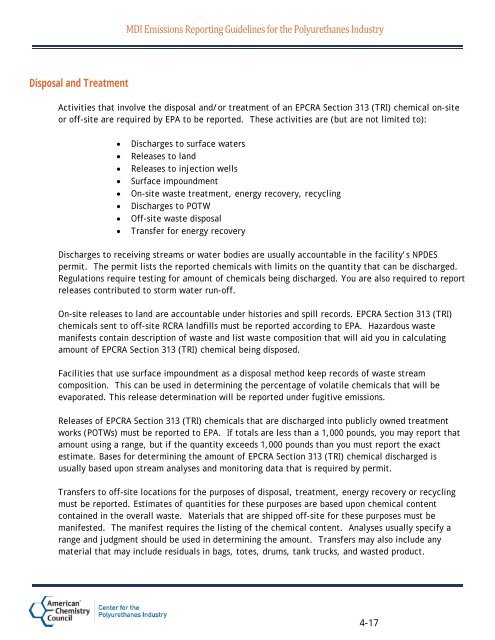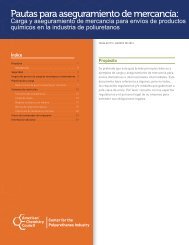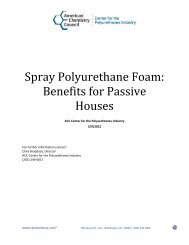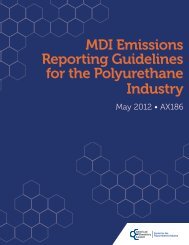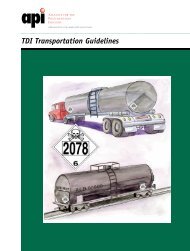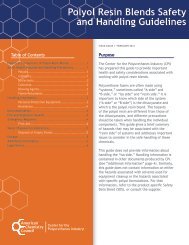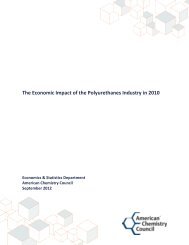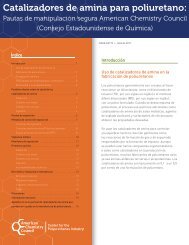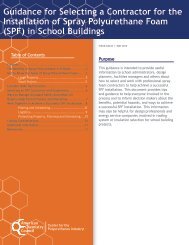MDI Emissions Reporting Guidelines for the ... - Polyurethanes
MDI Emissions Reporting Guidelines for the ... - Polyurethanes
MDI Emissions Reporting Guidelines for the ... - Polyurethanes
Create successful ePaper yourself
Turn your PDF publications into a flip-book with our unique Google optimized e-Paper software.
Disposal and Treatment<br />
<strong>MDI</strong> <strong>Emissions</strong> <strong>Reporting</strong> <strong>Guidelines</strong> <strong>for</strong> <strong>the</strong> <strong>Polyurethanes</strong> Industry<br />
Activities that involve <strong>the</strong> disposal and/or treatment of an EPCRA Section 313 (TRI) chemical on-site<br />
or off-site are required by EPA to be reported. These activities are (but are not limited to):<br />
Discharges to surface waters<br />
Releases to land<br />
Releases to injection wells<br />
Surface impoundment<br />
On-site waste treatment, energy recovery, recycling<br />
Discharges to POTW<br />
Off-site waste disposal<br />
Transfer <strong>for</strong> energy recovery<br />
Discharges to receiving streams or water bodies are usually accountable in <strong>the</strong> facility’s NPDES<br />
permit. The permit lists <strong>the</strong> reported chemicals with limits on <strong>the</strong> quantity that can be discharged.<br />
Regulations require testing <strong>for</strong> amount of chemicals being discharged. You are also required to report<br />
releases contributed to storm water run-off.<br />
On-site releases to land are accountable under histories and spill records. EPCRA Section 313 (TRI)<br />
chemicals sent to off-site RCRA landfills must be reported according to EPA. Hazardous waste<br />
manifests contain description of waste and list waste composition that will aid you in calculating<br />
amount of EPCRA Section 313 (TRI) chemical being disposed.<br />
Facilities that use surface impoundment as a disposal method keep records of waste stream<br />
composition. This can be used in determining <strong>the</strong> percentage of volatile chemicals that will be<br />
evaporated. This release determination will be reported under fugitive emissions.<br />
Releases of EPCRA Section 313 (TRI) chemicals that are discharged into publicly owned treatment<br />
works (POTWs) must be reported to EPA. If totals are less than a 1,000 pounds, you may report that<br />
amount using a range, but if <strong>the</strong> quantity exceeds 1,000 pounds than you must report <strong>the</strong> exact<br />
estimate. Bases <strong>for</strong> determining <strong>the</strong> amount of EPCRA Section 313 (TRI) chemical discharged is<br />
usually based upon stream analyses and monitoring data that is required by permit.<br />
Transfers to off-site locations <strong>for</strong> <strong>the</strong> purposes of disposal, treatment, energy recovery or recycling<br />
must be reported. Estimates of quantities <strong>for</strong> <strong>the</strong>se purposes are based upon chemical content<br />
contained in <strong>the</strong> overall waste. Materials that are shipped off-site <strong>for</strong> <strong>the</strong>se purposes must be<br />
manifested. The manifest requires <strong>the</strong> listing of <strong>the</strong> chemical content. Analyses usually specify a<br />
range and judgment should be used in determining <strong>the</strong> amount. Transfers may also include any<br />
material that may include residuals in bags, totes, drums, tank trucks, and wasted product.<br />
4-17


